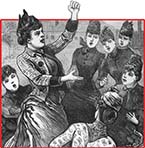American Issues  Connector: U.S. Women in American Society
Connector: U.S. Women in American Society

While many women today have successful careers, some still feel limited in their efforts to land higher positions in their chosen fields.
TRACK THE ISSUE
![]() Why do Americans disagree over women’s rights?
Why do Americans disagree over women’s rights?
In early America, women had few legal rights. They could not vote, hold office, or work at most jobs. Married women could not own property and were under the legal authority of their husbands. The women’s movement helped change all this. Nevertheless, Americans still remain divided over women’s rights. Use the time-line below to explore this enduring issue.
-
1848 Seneca Falls Convention
Women meet in upstate New York to declare support for women’s rights
-
1869 The National Woman Suffrage Association
Anthony and Stanton form organization to fight for women’s suffrage
-
1920 Nineteeth Amendment
Women gain right to vote
-
1964 Title VII of the Civil Rights Act
Law protects women against job discrimination
-
1972 Title IX of the Education Codes
Law bans sex discrimination in schools

Supporters of women’s suffrage gather in protest.
DEBATE THE ISSUE
Women in the Workplace On average, women earn less than men in the workplace. This wage gap has led to charges of sex discrimination. Feminists also argue that a “glass ceiling” keeps many women from rising to the top of their profession. But other factors may be involved, too.
“The wage gap is the result of a number of factors in addition to discrimination, such as the differences in women’s education, their shorter time in the workforce, and their concentration in a narrow range of jobs that are underpaid because women are in them. Nonetheless, a significant portion is attributable to discrimination.”
—Sonia Pressman Fuentes, founding member, National Organization for Women
“[Feminists] often portray working women as victims of rampant discrimination [which] [they say] … renders women powerless in the face of an impenetrable glass ceiling. While discrimination does exist in the workplace, levels of education … and time spent in the workforce play a far greater role in determining women’s pay and promotion.”
—Naomi Lopez, Director, Center for Enterprise and Opportunity
 TRANSFER Activities
TRANSFER Activities
- Compare How do the two writers agree? How do they disagree?
- Analyze Affirmative action makes it possible for women and minorities to compete in the workplace. Which of the two women quoted above might support it?
- Transfer Use the following Web site to see a video, try a WebQuest, and write in your journal. Web Code: neh-7602




